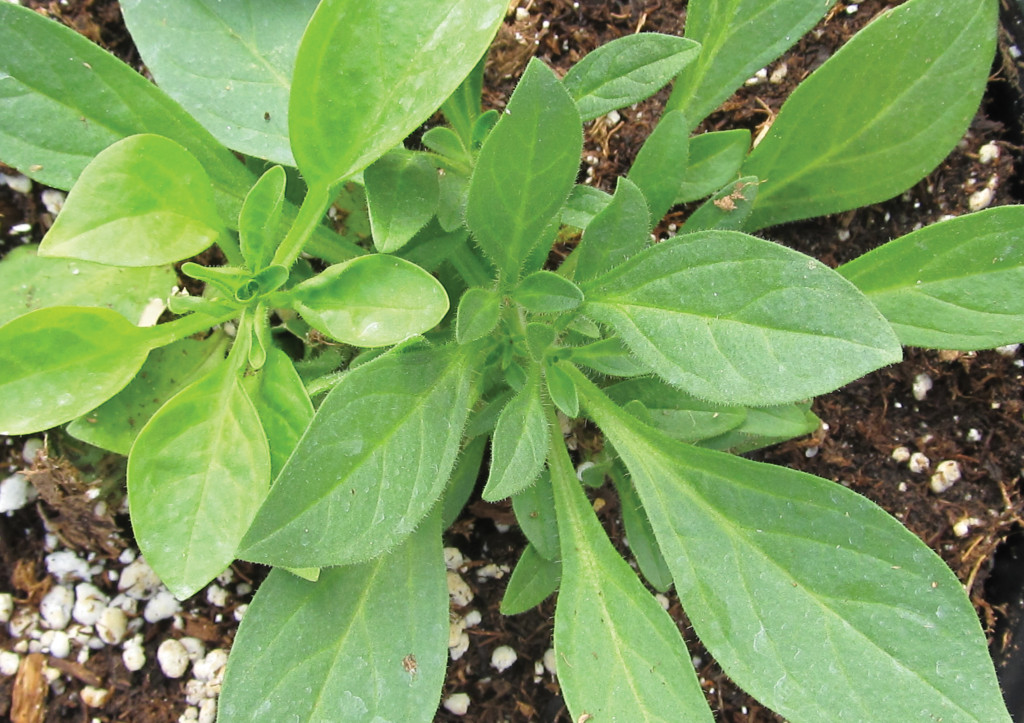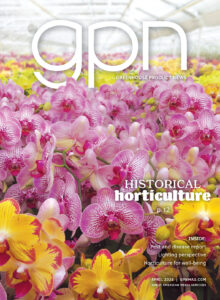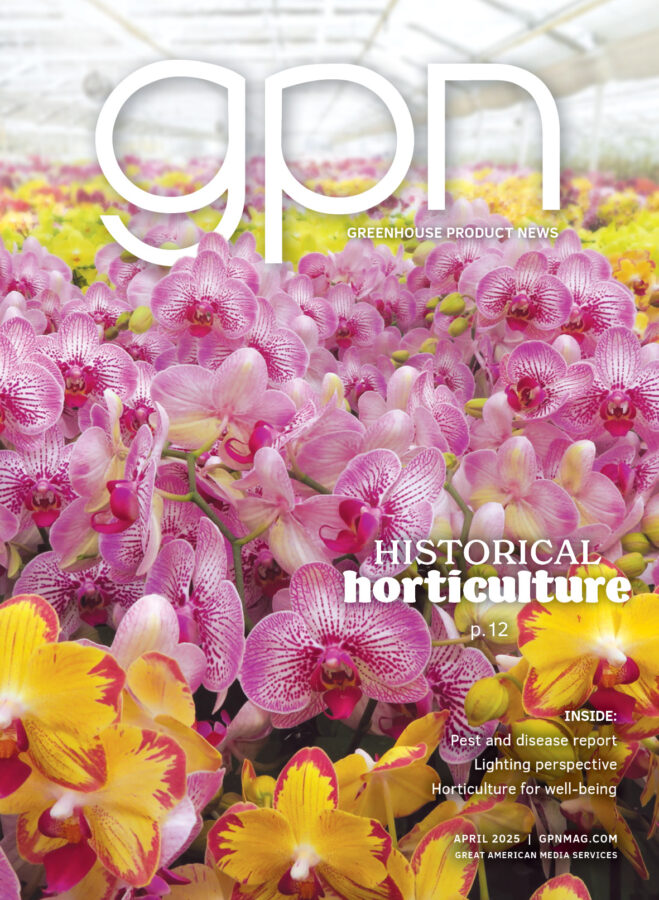
The Truth About Milk and TMV
Tobacco Mosaic Virus (TMV) resurfaced as a serious concern in production of vegetatively propagated petunias. TMV is geographically widespread and economically significant. TMV is transmitted mechanically and is not known to have an invertebrate vector like some other viruses. It is very stable and persists in the soil and on surfaces and can survive almost 50 years in dead, dried plant tissue.
TMV has a very wide host range (estimated at 200 species). Some of the known hosts are: achimenes, bougainvillea, calibrachoa, capsicum, columnea, cyclamen, geranium, gerbera, gloxinia, impatiens, lisianthus, lycopersicum (tomato – ToMV), nepeta, nicotiana (tobacco-TMV), osteospermum, penstemon, petunia (distinct strains), phalaenopsis (ORSV), phlox, rhoeo, stephanotis, stokesia and verbena.
TMV can spread through infected cuttings, handling, cutting tools, contaminated benches or other surfaces, contaminated soil and potting media and is rarely seed-borne. TMV is the type species of tobamovirus group which includes tomato mosaic virus (ToMV) and Odontoglossum ringspot virus (ORSV – Cattleya, Cymbidium, Dendrobium and Phalaenopsis). The petunia strains have been found to be unique genetically, causing symptoms that include color break (flowers), rugosity (roughness on leaves), stunting, mottling and mosaic, leaf deformity and vein clearing.
Control is achieved through use of pathogen-free transplants or cuttings. Scouting and roguing symptomatic plants is critical but not all infected plants show symptoms and they can act as a source of virus spread. Disinfesting tools is also important and has been researched extensively in the past five years. Workers’ clothing can also act as a means to spread plant pathogens from bacteria to fungi. Other control strategies are scouting plants regularly (especially those newly arrived in your operation), removing and discarding all plants with symptoms, clean benches and other surfaces in a greenhouse where TMV has been diagnosed. Finally, have symptomatic plants tested by a lab (or use test strips) as quickly as possible once they are found. The sooner you know you have TMV, the faster you can take steps to stop additional losses through spread.
One of the most critical pieces to an effective control strategy is using the most effective disinfestant to prevent transmission of the virus. They might be used on plants (as with the tobacco transplant industry), cutting tools and cleaning surfaces like benches or clothing. Characteristics of effective disinfestants should include :
• safety to people, equipment, environment
and plants
• work quickly — less than one minute
• inexpensive and widely available
• highly effective and reliable
• stable in a greenhouse environment
• broad-spectrum
• legal to use
A Review of Studies on Disinfestants and TMV
In 1959, Hare and Lucas reported that contact transmission of TMV was prevented or reduced by use of milk products on pepper, tobacco and tomato. The effect was best when milk (homogenized, canned or dried) was sprayed onto plants within 24 hours of inoculation. They did mention that the milk should dry before handling.
In 1960, Hare and Lucas tested the effect of pH and milk on TMV particles. The largest number of lesions occurred at pH 6 to 7, with lower counts at pH 8 and nearly none at pH 10. Lesions were reduced at pH 4.4 and almost none at pH 3.1. At a pH lower than 3.1 or higher than 10 no virus particles recovered.
Milk inactivated the virus almost 100 percent at pH 6.7 but if the solution was diluted significantly nearly all of the virus could be recovered in the active form.
In 1963, Denby and Wilks tested transmission of ToMV in tomato transplants. They found that dipping tomato plants in reconstituted skim milk was phytotoxic to a high degree but did reduce spread of the virus. An alternative method for application of spraying plants and allowing them to dry thoroughly before pulling for transplanting was safe to the plants and reduced virus spread 41 percent.
In 1964, Milinko tested sanitation methods for TMV in a greenhouse. They found that 2 percent formaldehyde, steaming, flaming soil or propagation boxes, and treating seeds or tools with 2 percent NaOH was effective. Skim milk, whey and full milk were equally effective, giving nearly 100 percent protection. These milk products worked on the outside of the plant for 10 days at most when a 20 percent milk solution was used. They caution about the likelihood of promoting sooty mold, but say it is easy to control with Zineb or Maneb mixed in the milk.
In 1979, Reilly looked at sodium alginate compared to milk. Milk was recommended in the tobacco industry as a hand wash but washing in phosphate detergent was found to be more effective. Milk residue on plants and surfaces is affected immediately by rainfall/irrigation and plant growth. They recommend milk spray on transplant beds of tobacco and phosphate hand wash.
In 1989, Pategas, Schuerger and Wetter investigated an outbreak of ToMV in hydroponic peppers which caused necrotic local lesions and leaf drop. They showed ToMV 70 percent transmission on untreated shears. Treatment of shears with 10 percent TSP showed the least transmission at 3 percent. Using 0.26 percent NaOCl and 0.01 percent Ivory Liquid resulted in 17 percent transmission while 0.26 percent NaOCl alone gave 22 percent. The quaternary ammonium RD20 allowed 39 percent when used at 0.4 percent. Solutions that were ineffective were rinsing in sterilized deionized water, 70 percent ethanol or 0.01 percent Ivory Liquid alone.
In 1994, Hu, Ferreira, Xu, Lu, IHA, Pflum and Wang evaluated disinfestants for Cymbidium Mosaic Virus and ORSV in orchids. When plants were inoculated with CyMV they found the virus in inoculated plants in 3 days and it readily became systemic over time. ORSV was not typically systemic. Skim milk was not effective on CyMV. Table 1 shows the effects of various concentrations of bleach or sodium hydroxide on transmission of ORSV. Use of bleach at 10 to 20 percent was 100 percent effective but phytotoxic and damaging to tools. Use of NaOH was 100 percent effective at rates between 1 and
20 percent.
In 2010, Lewandowski, Hayes and Adkins published an extensive series of trials on TMV in petunia. The wild type of TMV and 4 other tobamoviruses all infected petunias without symptoms while petunia strains caused severe symptoms on all but one cultivar tested. They demonstrated that TMV could be transmitted in up to 20 consecutive plants after a knife was contaminated by cutting an infected plant.
Disinfestants tested were 20 percent wt/vol nonfat dry milk plus 0.1 percent Tween or 1:10 bleach – 0.6 percent sodium hypochlorite were the most effective in eliminating transmission in petunia. Milk and 1 percent wt/vol Virkon significantly reduced TMV survival on knives. Table 2 shows some of their data.
In 2012, Losenge, Faust and Scott reported on trials to evaluate effects of incubating infested tools to eliminate TMV. Treating tools for 5 min eliminated TMV in TSP and a combo of sodium hypochlorite and sodium hydroxide. Ten min eliminated TMV in nonfat powdered milk or bleach and 98% was eliminated in ethanol. Clothing has also been found to transmit TMV including latex, high-density polyethylene fibers and cotton, which all transmitted TMV between 35 to 57 percent even with only slight brushing. The virus could stay active when infested clothes were stored in dark for three years. This data suggests that washing in detergent is the most effective way to deactivate TMV on clothing.
Table 3 shows the ability of various solutions to eliminate transmission of TMV from hands.
Finally, when we saw the outbreak of TMV in petunias early this year, a number of people shared some details of their unpublished work on TMV. LaMondia who was working in the tobacco industry at the time, stressed the need for repeated hand washing or wearing gloves and no smoking. All tobacco products have tested very high for presence of TMV. Washing hands well with soap and water has the best impact on virus removal and inactivation. Spraying tobacco transplants with milk (20 l whole milk or 2.5 kg dried skim milk in 20 L water per 100 m2 of bed) within 24 hours of pulling is suggested. Workers dip hands in milk every 20 min or less.
Conclusions About Milk
1. Reconstituted nonfat dry milk (NFDM-most studies report 20 percent wt/vol) can be very effective in reducing TMV activity on surfaces including plants, tools and clothing.The exposure time differs depending on the subject treated. Dipping tools is not effective – 10 min exposures work best.
2. The treatment can work on plants up to 10 days based on research. I could not find any research to indicate that it had to stay wet to work. The effect of the milk will wear off with overhead irrigation, rainfall or just growth of new leaves.
3. Adding Tween at 0.1 percent improves the effect of milk.
4. Milk can promote sooty mold growth. NO tests are published on mixing milk for virus and fungicides to control sooty mold. Our tests on sooty mold control with fungicides alone were unsuccessful.
5. Using milk to control the virus is not a legal registered use and in some states regulations may be an issue.
6. It is not an inexpensive product in that it costs around $4/gal or $400/100 gal. This would be considered very expensive by many growers.
Steps to Prevent TMV Introduction
1. Examine new cuttings for symptoms of the virus (and anything else you don’t want such as
bacteria and insects).
2. Do not assume you can tell which cuttings have the virus by sight alone.
3. If you find symptomatic plants in a bag of cuttings, test them using virus test strips or send to a lab.
4. It is safest to assume that if one cutting in a bag has TMV the others have it or at least have been exposed to it and the whole bag should be rejected.
If an Outbreak of TMV Occurs
1. If you have virus symptoms on petunias (or other TMV hosts) that are confirmed as TMV, you must assume that all plants in that ship week and cultivar have a high chance of being infected.
2. That means they are all trash and should be removed using gloves.
3. It may be helpful to spray plants that are being rogued with 20 percent NFDM the day before handling. Allow to dry before handling plants.
4. Take care to only touch plants that are being removed since you can inadvertently spread TMV to others in the same or nearby baskets.
5. Do not replant with another plant that can get TMV. The likelihood that the pot or potting medium has virus particles is high and the new plant can easily become infected through the planting process.
6. Since TMV has such a wide host range it is going to be hard to find one to replace the missing one in a mixed basket. Remember Calibrachoa and Verbena are TMV hosts too.
7. The most cost-effective step is to dump the whole basket.
8. Have workers wear gloves and change them as often as you can tolerate the cost. They can also dip hands with or without gloves in the NFDM solution at least every 20 minutes. Other solutions such as bleach are very effective as well but not as user-friendly (for plants or people).
The Truth About Milk and TMV









 Video Library
Video Library 


















